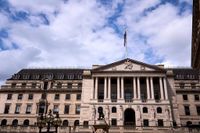On August 7, 2025, the Bank of England delivered a decision that set the financial world abuzz: a 0.25 percentage point cut to the base interest rate, bringing it down to 4.00%, its lowest level since March 2023. But while a rate cut was largely anticipated, the way it unfolded—and the signals sent about what comes next—left markets and analysts parsing every word and vote for deeper meaning.
The Monetary Policy Committee (MPC), the panel responsible for setting the UK’s interest rates, found itself deeply divided. According to FXStreet, the initial vote was split right down the middle: four members wanted to keep rates unchanged, four favored the 25 basis point cut, and one even pushed for a more aggressive 50 basis point reduction. With no clear majority, a second ballot was called. Only then did a narrow majority—five to four—tip the scales in favor of the smaller cut.
This narrow decision, as Commerzbank’s FX analyst Michael Pfister observed, was a “clear hawkish surprise” compared to what many in the market expected. Rather than signaling a rush to lower rates further, the split vote and subsequent commentary suggested a central bank treading cautiously. The pound sterling, perhaps unsurprisingly, appreciated following the announcement, a sign that traders interpreted the move as a sign that borrowing costs might stay higher for longer.
Beneath the headline, though, the Bank’s message was anything but straightforward. During the press conference, Bank of England Governor Andrew Bailey stressed the “genuine uncertainty” about the future path of monetary policy. As reported by BBC and echoed in The Guardian, Bailey called the decision “finely balanced,” citing divisions among committee members and a swirl of conflicting economic data. “I do think the path continues to be downwards,” Bailey said, before quickly adding, “There is however genuine uncertainty about the course of that direction of rates. The path has become more uncertain because of what we are seeing.”
What’s fueling all this uncertainty? Inflation, for starters. The Bank raised its forecast for September 2025, now expecting the consumer price index (CPI) to peak at 4%—a full half-point higher than previous guidance, and double the Bank’s long-term 2% target. That’s a sobering prospect for households already feeling the pinch. The rise, according to the Bank’s own analysis, is being driven by stubbornly high energy and food prices. Items like beef, chocolate, and coffee have all seen sharp price increases in recent months, adding to the cost-of-living squeeze on British families.
Looking further ahead, the Bank of England expects inflation to remain above its 2% target for the next two years, only falling below that benchmark by 2027. That’s a long time for consumers and businesses to wait for relief—and it’s one reason why the MPC’s decision was so contentious. Some members argued for holding rates steady, wary of stoking further inflation, while others believed a more aggressive cut was needed to support an economy still grappling with global uncertainties and sluggish growth.
It’s not just the inflation numbers that are giving policymakers pause. As FXStreet and BBC both noted, there are signs that pay growth has slowed, and the impact of US tariffs has become less uncertain. But these positives are offset by persistent risks—both upside and downside—to the inflation outlook. Governor Bailey was candid about the challenge: “There are both upside and downside risks to the UK’s inflation level.”
Economists outside the Bank are just as divided. Sandra Horsfield, an economist at Investec, told BBC she expects another 0.25 percentage point cut in November, followed by further reductions in 2026, eventually bringing the base rate down to 3% by next summer. But she also admitted, “our confidence in this view has diminished,” citing the need for clear evidence that disinflation is continuing, especially in the service sector. Liz Martins, senior UK economist at HSBC, echoed this caution, noting, “With the Bank now forecasting inflation running at double its target in September, it’s no wonder they sound a bit cautious about the scope to reduce rates further. While we ultimately think that evidence of further disinflation will materialise, allowing the Bank to keep on cutting, today’s hawkish communications open the door to a pause if it doesn’t.”
Rob Wood, chief UK economist at Pantheon Macroeconomics, offered a slightly different take, predicting the MPC will keep rates unchanged for the rest of the year as it prioritizes keeping inflation low. “It’s still far from a slam dunk – jobs growth could remain weak and uncertainty about autumn tax hikes could hit demand,” he said.
For borrowers, the immediate impact of the rate cut is likely to be positive. Lower rates should mean cheaper mortgages and reduced borrowing costs for businesses. Chancellor Rachel Reeves was quick to highlight the benefits, calling the cut “good news for people wanting to get on the housing ladder, people remortgaging and also businesses borrowing to grow.” But the Chancellor faces her own challenges: speculation is mounting that she may be forced to raise taxes in her autumn Budget, with the NIESR think tank warning of a £41 billion shortfall on one of her fiscal rules.
On the government’s balance sheet, the cut is expected to reduce debt payment costs, offering a bit of breathing room as public finances remain under strain. Yet, as FXStreet cautioned, markets and instruments are subject to risks, and all investment decisions should be made with care. The broader message from the Bank and analysts alike is that the road ahead is anything but certain.
So, what happens next? The timing of any further rate cuts remains up in the air. As Michael Pfister noted, “The September meeting now seems highly improbable, and if inflation remains high until then, even the November meeting could be called into question. For the time being, this is good news for the pound.” The Bank itself is signaling that while rates are unlikely to rise again soon, they’re not in a hurry to cut further unless inflation shows clear signs of cooling.
In the end, the Bank of England’s August decision was a study in contrasts: a rate cut that was both expected and unexpectedly contentious, a move that brought some relief but also raised new questions. For now, policymakers, economists, and ordinary Britons alike are left watching the data, waiting for the next signal, and hoping for a little less uncertainty in the months ahead.

